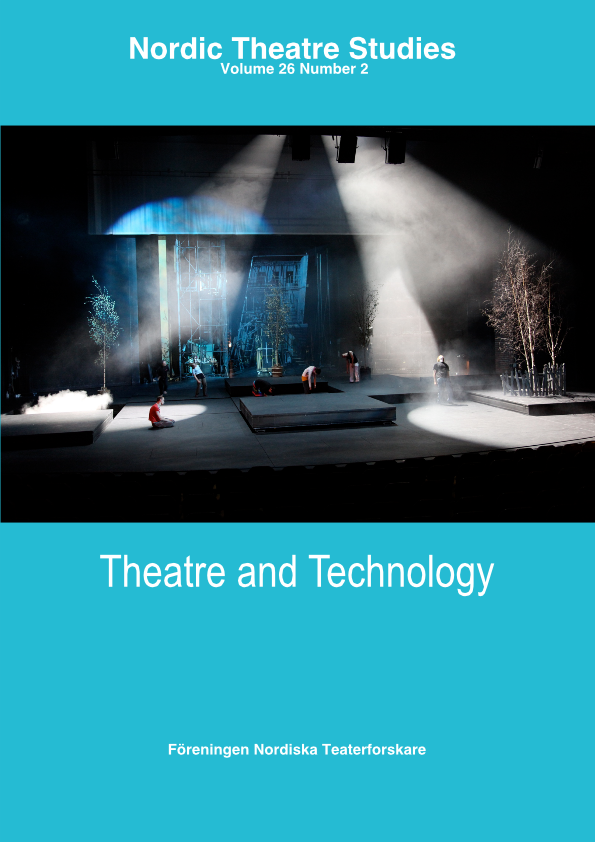Finnish Theatre Photography and the Influence of Technology
DOI:
https://doi.org/10.7146/nts.v26i2.24310Keywords:
photography, theatre, technology, image, performanceAbstract
This article is mainly based on interviews with three Finnish photographers’, Kari Hakli, Jalo Porkkala, and Petri Nuutinen’s as well as on the theatre photographs they have taken. The criterion for selecting these three photographers has been that their work spans a number of decades; therefore, the development of Finnish theatre photography can be studied from this perspective. The theatre photograph is a photo of the stage image, which is often based on the dramaturgy of the play script. The subjects and points of view of the photographer are not generally agreed on in advance with the director or the actors, but they are based on the photographer’s own estimations and views. He/she interprets and transmits the performance to the audience with his images, and works in between the theatre and the spectator, but he is not the artistic producer when photograph- ing, the performance is, i.e. he/she has not chosen lights, costumes or set design. Technology has had a significant influence on the theatrical image and pho- tographic equipment. With the development of materials and equipment, the making of theatre photographs has shifted from a static process into a more dynamic one. Finnish theatre photography has reacted quickly to aesthetic trends in both theatre and photography. In the past it was possible to photograph only static or slow-moving objects in a set situation or in a pose. Today, the photographer can move among the actors, photograph fast-moving objects with a handheld camera using the stage lighting without the need for additional lights. The images look more as if they have been taken by an insider, someone who belongs to the team, rather than by an intruder. Theatre photographs are nowadays needed in the same way they have always been needed, as documents of the performance.References
Annette Arlander, Esitys tilana. Acta Scenica 2, The Theatre Academy, Helsinki 1998.
Henry Bacon, “Tulkitsemisen taito: Paul Ricoeurin kaksi hermeneutiikkaa” in Mediatutkimuksen vaeltava teoria, Tuomo Mörä, Inka Salovaara-Moring, Sanna Valtonen, eds., Gaudeamus, Helsinki 2004.
Hans-Georg Gadamer, Hermeneutiikka. Ymmärtäminen tieteissä ja filosofiassa, Vastapaino, Tampere 2004. (Original articles included in Gesammelte Werke, Parts 2 and 4, J. C. B. Mohr, Tübingen 1986 and 1987.)
Kari Hakli, Aika. Valokuvaajan Suomenlinna. En photograf ser på Sveaborg. Photographers Suomenlinna, Musta Taide - Finnfoto, Helsinki 1998.
Kari Hakli, “Teatterivalokuvauksen nousu ja rappio” [The Rise and Fall of Theatre Photography] in Teatteri, no. 7, 2011.
Hanna-Leena Helavuori, Jukka Kukkonen, Riitta Raatikainen, Tuomo-Juhani Vuorenmaa, eds., Valokuvan tanssi. Suomalaisen tanssin kuvat 1890–1997. Dance in Finnish Photography, Pohjoinen, Oulu 1997.
Marcus B. Hester, La métaphore vive, Seuil, Paris 1975.
Barbara Hodgdon, “Photography, Theater, Mnemonics; or, Thirteen Ways of Looking at a Still” in Theorizing Practise: Redefining Theatre History, W. B. Worthen and Peter Holland, eds., Palgrave Macmillan, London 2003.
Hanna Meretoja, “Itseymmärryksen kulttuuris-historiallinen välittyneisyys Gadamerin ja Ricoeurin hermeneutiikassa” in Kohtaamisia ajassa. Kulttuurihistoria ja tulkinnan teoria, Cultural History - Kulttuurihistoria 3, Sakari Ollitervo, Jussi Parikka, Timo Väntsi, eds., k&h, Turku 2003.
Jalo Porkkala, Köyhä dagerrotyyppi – alternative photographic processes, Satakunta University of Applied Sciences, Pori 2012.
Thomas Postlewait, “Historiography and the Theatrical Event: A Primer with Twelve Cruxes” in Näkökulmia menneeseen. Teatterihistorian kirjoittamisen perusteita ja käytännön sovellus: Uusi Teatteri 1940–1941, Pirkko Koski, ed., The Theatre Museum, Helsinki 1997.
Lauri Rauhala, Hermeneuttisen tieteenfilosofian analyyseja ja sovelluksia, Yliopistopaino, Helsinki 2005.
Lauri Rauhala, Eksistentiaalinen fenomenologia hermeneuttisen tieteenfilosofian menetelmänä, Tampereen yliopisto, Tampere 1993.
Seppo Sajama, “Identiteetin ajallisuus” in Aika, Sami Pihlström, Arto Siitonen, Risto Vilkko, eds., Gaudeamus, Helsinki 2000.
Saraste, Leena. Valokuva. Muisto, viesti, taide, Musta Taide, Helsinki 2010.
Rebecca Schneider, “A Small History (of) Still Passing” in Dynamics and Performativity of Imagination. The Image between the Visible and the Invisible, Bernd Huppauf and Christoph Wulf, eds., Routledge, New York 2009.
Downloads
Published
How to Cite
Issue
Section
License
The copyright belongs to the authors and Nordic Theatre Studies. Users can use, reuse and build upon the material published in the journal but only for non-commercial purposes. Users are allowed to link to the files, download the files, distribute the files on a local network (preferably by links), upload the files to local repositories if their institutions require them to do so, but not republish the files without proper agreements with the journal and the author.

